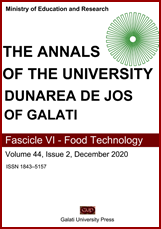Study of structural-mechanical characteristics of emulsion-foam systems of milk cream and hydrocoloids
Abstract
The current trends in food production are aimed at creating products with reduced energy value. The present study investigates the emulsion-foam structures of the cream from churned cream with a 20% fat content used in decorating flour confectionery. It is proposed to stabilise such systems by the introduction of sodium alginate, ι-carrageenan or gelatin. It was determined that the emulsion-foam structures of the cream samples under investigation belong to the class of pseudoplastic non-Newtonian fluids. The different values of the conditional dynamic limit of fluidity were determined: for sodium alginate ~ 100 Pa, for ι-carrageenan ~ 35 Pa, for gelatin – 66 Pa, which is connected to a high level of swelling of the hydrocolloids in cream and their differences in structure-forming manners. Within 2 hours upon obtaining, all samples are characterized by a decrease in the total deformation of the sample. For the samples under study, plastic deformations exceeded springy deformations. In the structure of the experimental samples, plastic deformations exceeded springy deformations: the relative plastic deformation of the samples of emulsion-foam systems after churning was 98… 99%. Over time a part of the springy deformation increased for the samples with gelatin and sodium alginate, and decreased for the samples with ι-carrageenan.


